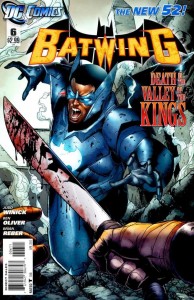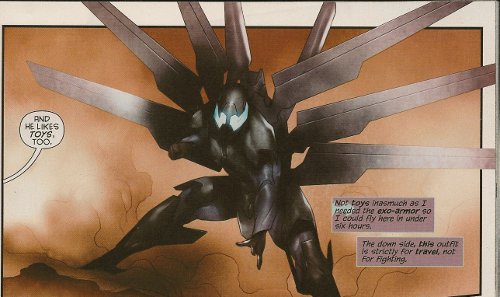 Batwing has been one of the weirder and more interesting books of the New 52. It leverages Grant Morrison’s Batman Incorporated concept – Bruce Wayne finances local Batman franchises around the world, possibly because Batman believes that Starbucks are a superstitious, cowardly lot – and uses it to answer a question that only a few comics have tried to address: if there are superheroes, why don’t they go after real scumbags in places that make Gotham City look like Metropolis after a massive federal grant to finance free beer for the sad?
Batwing has been one of the weirder and more interesting books of the New 52. It leverages Grant Morrison’s Batman Incorporated concept – Bruce Wayne finances local Batman franchises around the world, possibly because Batman believes that Starbucks are a superstitious, cowardly lot – and uses it to answer a question that only a few comics have tried to address: if there are superheroes, why don’t they go after real scumbags in places that make Gotham City look like Metropolis after a massive federal grant to finance free beer for the sad?
In a nutshell, Batwing puts a version of Batman in the Congo, smack in the middle of one of those hellholes that have been at civil war for so long they call it Tuesday. Batwing didn’t lose his parents to a killer, he lost them to AIDS and was drafted by one of those tinpot shitsplat warlords who whip up armies of children because children haven’t learned to say “no,” or, “that’s wrong”, or “tinpot shitsplat dictator.” Or at least that haven’t learned to say that last one with the level of derision it deserves.
So instead of a Batman moved to fight crime based on seeing a murder during his childhood, we have one who is moved to fight crime after being a murderer during his childhood. And he’s doing it in a country so loaded with corruption and casual daily horrible crime that it really feels like it needs a Batman. Which is a cool concept, and it generally works… but for a book that packs an extra punch by being based in a truly horrible place in real life, it doesn’t meet the level of realism I’ve come to expect from a Batman comic… which sounds stupid, but bear with me.
Batwing #6 focuses on the battle with an unstoppable, ethnic, machete-wielding killing machine named Danny Trejo – sorry, I meant Massacre – who is systematically hunting down former members of a superhero team. In this particular issue, he’s chasing a millionaire entrepreneur who was formerly an armored member the the team Tony Stark, a.k.a. Iron Man – damn these typos! I meant Daniel Balogun, a.k.a. Steelback! Just in the nick of time, Batwing arrives wearing Grendel armor…
…sorry; I meant a Batman flight suit so advanced that I’ve never even seen Batman wearing one. And as they fight, Batwing learns that Massacre might be a pivotal person from his past when he utters his blood-chilling lifetime catchphrase: “Have you ever danced with the devil in the pale moonlight?” – fuck! That was supposed to read, “We honor them all in blood!” Clearly, I’m too hung over to write this!
The point is that for such and original core idea in a comic book, writer Judd Winick fills it with one hell of a lot of derivative ideas. None of these are deal-breakers, and the overall plot, action and characterization keeps the book from screaming, “Swipes! Swipes, here!” but they add up.
And then there’s the realism problem… and don’t get me wrong; I’m not talking about the realism level of what a hellhole this fictional area of the Congo is. I’m no expert on the area, but I’ve read enough about limpdicked douchebags like Charles Taylor and his ilk to generally buy into the overall scenario. No, I mean the Batman level of realism, if that makes any sense. We have ready and ample popular culture evidence of how Batman deals with criminals in foreign countries – look at Christopher Nolan’s The Dark Knight; Batman infiltrates, dominates with superior technology, acts quickly and overwhelmingly, and immediately escapes without regard for local law (Or any law other than murder, actually), even when the local constabulary sees it in IMAX.
If Batman – even a Batman analogue – paid an interest in the stuff going on in the Congo, I would expect these warlords to start waking up Batcuffed in the Hague before they had the time to say, “Huh… that’s an awful big bat, even for central Africa.” Instead, Winick’s given us six issues of Batwing flitting around half a step behind Massacre, even when Batman himself is there to help.
And frankly, if you’re going to set a book in a civil war-torn African country, why is Batwing fucking around with a dude going after a few former superheroes when a couple miles away there’s a dude in a homemade uniform ordering children to wipe out entire towns? It’s like Batman swinging past The Joker skulking around the Gotham Reservoir in favor of setting up a long-term stakeout on a potential pickpocket.
The art by penciler Ben Oliver and inker / colorist Brian Reber, is generally impressive. the figures and facial expressions tend toward realism, with a cool-looking painted coloring effect that looks a little airbrushed. Oliver splits his pages generally into four page-wide panels drawn angled off the perpendicular, giving the pages an interesting look and allowing him to angle panels to serve the action (For example, when he wants to show Batwing throwing a billy club at an up angle, all the panels can be angled upwards at the right to keep a page-wide action panel). The storytelling is generally clear, and to my eye improved from the first issue, where I had a few occasions where I had to stop and reread to figure out who was doing what and when. The team does several panels in flat-black silhouette, which is never a bat choice when that silhouette looks like Batman. It’s a good look for the book, which I enjoyed quite a lot.
All in all, Batwing feels like a bold and interesting experiment that doesn’t quite live up to expectations. It’s a new and unique take on the Batman family, that is unfortunately populated by old and familiar elements that distract. It places a Batman analogue in an environment where someone like Batman is desperately needed, and then has him tackle issues that seem less important than the ones that are implicitly happening in the background. And finally, they telegraph moving Batwing to Gotham City in issue 6, removing Batwing from his unique setting and frankly telegraphing that the a former warlord will be stomped by Robin and Nightwing in an !!IRONIC!! turn for the man who used to enslave children.
But even with all the flaws, I generally enjoyed the book. If you want a different kind of take on Batman, give it a flip-through at the comic store and consider it. Just be aware that, like many American actions in Africa, it’s loaded with good intentions… even if it doesn’t quite work all the time.

 Podcast RSS Feed
Podcast RSS Feed iTunes
iTunes Google Play
Google Play Stitcher
Stitcher TuneIn Radio
TuneIn Radio Android
Android Miro Media Player
Miro Media Player Comics Podcast Network
Comics Podcast Network